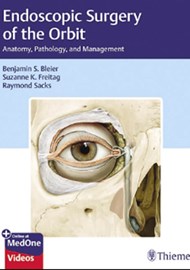Endoscopic surgery still remains a challenge for many oculoplastic surgeons, whose main scope of work has traditionally been open surgery. The learning curve for endoscopic surgery is quite steep and this approach requires skills that needs to be well trained, based on an extensive knowledge of the anatomy and its endoscopic landmarks.
The view from inside structures completely changes the way we visualise operations and actually operate and requires getting used to an utterly different way of planning and performing surgery.
This book, which comprises an inside trip into the orbit, addresses its main mysteries from an endoscopic perspective, from the anatomy to the proper management of pathologies using this technique, in a way that is accessible for several specialties that often work together in the area – ENT, orbital and skull base surgeons.
One of the strengths of this book is that it goes straight to the point and the readability is very easy and inviting. The illustrations are quite a good support to the text, which is intuitive and well connected. The presentation of the topics follows a clinical-based rationale: first a surgeon needs to have in mind and correlate anatomical and radiological images and structures to aid diagnosis and surgical planning, and the book covers the right depth to ensure it is not too boring or overwhelming.
The text then covers the condition and then finally goes on to explain the surgical techniques, both traditional approaches and endoscopic perspectives. All videos and photos complement a thorough understanding of the procedures and pathological processes, with the addition of handy tips from personal experience, which makes this textbook equally enjoyable and useful. The perioperative chapters are definitely the icing on the cake, exploring what considerations need to be taken into account to help ensure the best surgical plan.
If there are any negatives, I would say that some sections go into too much detail regarding pathophysiology. This could perhaps have been replaced or supplemented with more extensive information around endoscopy techniques, such as novel incorporations to this fascinating field like the use of navigation systems that neurosurgeons and ENT are already used to.Overall, this is a very good book, covering the typical questions that may arise in a person looking to specialise in this niche area. Definitely a must for orbital surgeons interested in implementing this technique into their practice.




